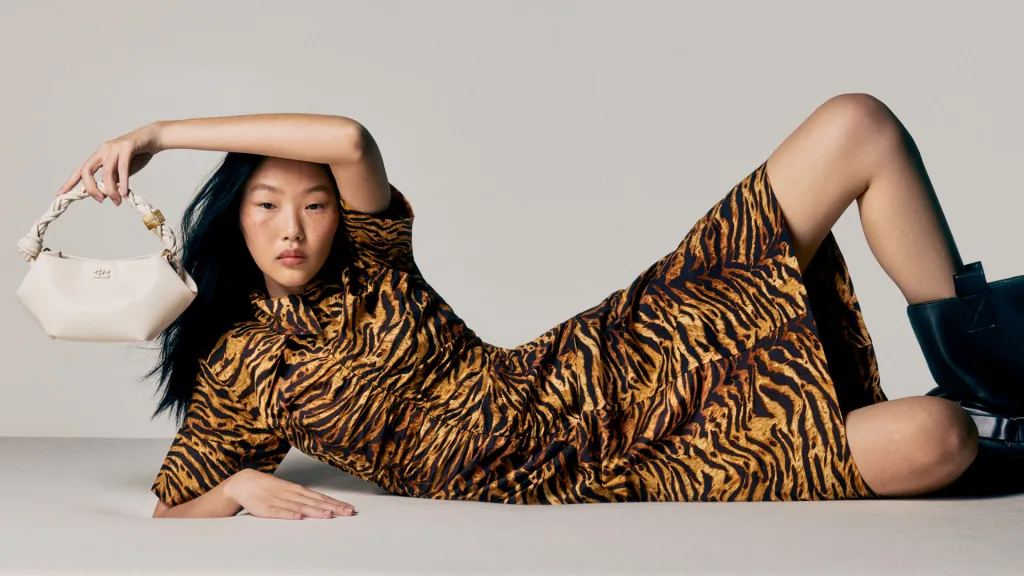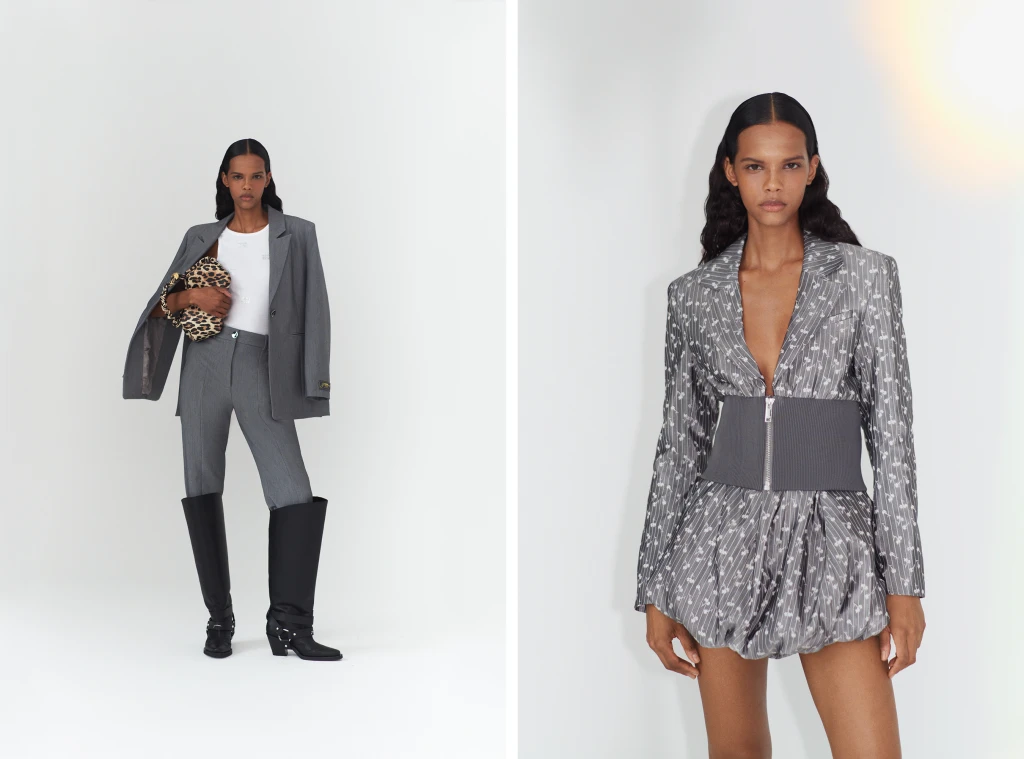How cool-girl brand Ganni made sustainable style a $700 million business
The Danish ‘It Girl‘ brand is determined to grow, but not at all costs.
In 2023, Nicolaj Reffstrup made a tough decision—one that would lose his company half a million dollars in annual revenue.

As cofounder and CEO of the edgy Danish fashion label Ganni, he saw the company’s $825 cowboy boots skyrocket to become its top-selling product. His wife, Ditte Reffstrup, the company’s cofounder and creative director, styled the boots in unexpected ways, with joggers or cargo pants. It was all part of the brand’s bold, irreverent aesthetic, which had developed a cult following, propelling Ganni to a $700 million valuation and prompting the luxury private equity firm L Catterton to buy a 51% stake in 2017.
Despite that success, Nicolaj decided Ganni had to stop making the boots in virgin leather and ultimately phasing out two popular colors of cherry red and tiger’s eye brown because they were so bad for the environment. “We couldn’t figure out how to dye the boots in a nontoxic way using virgin leather alternatives” Nicolaj recalls. “So we made the decision to stop making them without offering any kind of replacement. If you’re committed to becoming a sustainable brand, you’re going to have to make some really difficult decisions.”

The incident encapsulates Ganni’s approach to sustainability, which Nicolaj documents in a new book, The Ganni Playbook: How to Get Started Creating a Responsible Business, cowritten with journalist Brooke Roberts-Islam. The book lays out how fashion leaders seeking to build responsible businesses must be willing to prioritize expensive, eco-friendly options over profit. “There’s no consumer willing to pay a premium for sustainability,” Nicolaj says. “You need to sacrifice margins.”
Still, Nicolaj believes that it is possible to build a fast-growing sustainably minded business that is also profitable. And ultimately, he argues, doing so is crucial for sustainable fashion brands to scale and steal market share from polluting fast-fashion players like Shein and Temu. “As long as we’re still in the dynamics of a market economy, there needs to be growth,” he says. “Otherwise, people will stop investing in the green transition. I’d love to revolutionize the whole system, but it’s not going away.”

The Copenhagen Girl
The first thing you notice in Copenhagen is the cyclists who dominate the roads, speeding down the bike lanes at rush hour. But the Danes refuse to sacrifice style as they pedal to work. You’ll find women in practical, but fashionable looks: sneakers paired with leopard-print trousers or floral sundresses, prim blazers with denim cutoff shorts, cute purses slung on the handlebars.
Back in the early 2000s, Ditte couldn’t find a brand that she felt reflected the kinds of clothes she liked to wear. She wanted garments that were practical but stood out and allowed for self-expression. She wanted fabulous outfits that could be worn on a bike. “It’s a look that is about empowerment,” she says. “You need to be versatile, to cycle to the office, stop for a swim in the harbor after work. But you still want to dress up and look fancy.”

Ditte had spent her career as a buyer for fashion boutiques. Through her work, she met Frans Truelsen, a gallerist who had launched a small cashmere line called Ganni in 2000. By 2009, Truelsen was looking for a partner to help grow the company. The Reffstrups decided they were the right pair for the job. As creative director, Ditte helped create the distinct look she believed the market was missing. And Nicolaj, who had a background in building tech startups, wanted to build a long-lasting business. “I didn’t want to be the kind of brand that would blossom and then die away in 10 years,” he says. “You need muscle and scale to be able to sustain a brand over time.”
Under their leadership, the brand took off. Women in Copenhagen immediately gravitated toward Ganni’s mix of feminine prints and bright colors unexpectedly paired with menswear-inspired jeans and sport coats. The brand priced itself lower than luxury labels but higher than fast-fashion competitors, with jeans and dresses starting at $295.
From the outset, Nicolaj was eager to take the brand beyond Denmark, which has a relatively small population of fewer than 6 million people. And within a few years, Ganni could be found in other Scandinavian countries, then Western Europe, and eventually the United States. Today, the brand has a total of 70 stores worldwide, 21 of which are in the U.S., its biggest market, and 5 in its second-largest market, the U.K.

The Green Transition
When Ditte met Nicolaj in 2004, she remembers him as being already fixated on climate change. He was first drawn to the issue during university, when he became alarmed by the pace of global warming and how little governments were doing about it. As he was building Ganni with Ditte, he was able to observe firsthand how the fashion supply chain contributes to the crisis, spewing carbon into the atmosphere and pollution into the environment.
In 2013, four years into building Ganni, the pair decided to redesign every aspect of the business to curb its environmental impact. By 2016, they had developed a comprehensive plan. It started with mapping out the brand’s carbon footprint, then paying to offset it by subsidizing U.N.-approved clean cooking stoves for women in Nepal and Ghana who were previously using open fires that release a lot of carbon and also lead to health problems. “We were frustrated that politicians weren’t imposing a carbon tax because they just didn’t have the guts to do so,” Nicolaj says. “So we decided to introduce our own carbon tax on ourselves.”
By 2019, Ganni set a target of reducing 30% of its emissions per kilogram of product it produced. It also outlined 44 goals to reach over the following four years. This target was updated in 2022 to a 50% absolute carbon reduction vs. 2021 baseline. This included building an internal team of 19 people, called the “Carbon Squad,” who are devoted to decarbonization efforts. It involved phasing out virgin leather, having determined that it made up 58% of the brand’s carbon footprint, the largest source by far. It also invested in seven startups focused on innovative new materials, including a fabric-to-fabric recycling company called Circulose, a textile called Celium made by feeding bacteria with fruit waste, and a plush textile called Savian made from agricultural waste. Along the way, it offered the rest of the world insight into its goals—and its progress toward meeting them—on a dedicated Instagram feed called Ganni Lab.

In 2022, ahead of the timeline, Ganni achieved all of its goals from its 2019 sustainability strategy. Now the plan is to scale pilot projects by embedding new technologies and fabrics into its daily operations. Take its iconic purse, called the Bou Bag. The company had already started making it out of recycled leather. But now it’s transitioning to making it from more innovative materials such as Ohoskin, a material that looks like leather but is made from the by-products of orange and cactus farming.

Growth or Degrowth?
These sustainability efforts have consumed Ganni’s margins, but the brand has still managed to increase its revenues annually. It does this by winning over new consumers and selling more products across more markets every year. Nicolaj firmly believes that sustainable fashion businesses can have an impact only if they’re financially successful. In this modern market economy, that means they must grow.
Ganni’s approach flies in the face of degrowth, a movement that has gained traction over the past decade, arguing that the only way for the planet to survive is to radically cut production and consumption. The idea first emerged in the 1970s, but it has been debated extensively over the past few years.
From Nicolaj’s perspective, degrowth is a good idea, but it’s hard to execute in the current capitalist system. This is especially true as fast-fashion continues to show explosive growth. “I’m not opposed to degrowth, but I just cannot figure out how it would pan out,” he says. “I’ve learned firsthand that the second you get to a place where growth is slowing, people immediately stop investing in this area.”
Ganni’s growth has drawn investors. In 2017, L Catterton—the private equity firm cofounded by luxury conglomerate LVMH—acquired a majority stake in Ganni, believing in its potential for continued profitability. L Catterton lets the Reffstrups continue on their ambitious sustainability plans, even though they cut into profits. Over the past four years, Ganni has devoted 0.6% to 1.1% of its annual revenue to paying for its responsibility efforts. Meanwhile, revenue has increased upwards of 30% annually, largely due to the brand’s global expansion.
Given all this growth, Nicolaj’s goal is to try to find ways to make products with as little environmental impact as possible. Its current efforts—like offsetting carbon and using the least harmful dyeing technologies—are just the start. Nicolaj believes there are new technologies bubbling up that could potentially be transformative. He thinks about moonshots like Rubi Laboratories, whose technology sequesters carbon dioxide and transforms it into cellulose yarn. “We’re radically reducing our own carbon footprint now,” he says. “But we hope we can get to the day where we have a product that is actually getting carbon out of the atmosphere. I think technically, we can get there. The question is just how long will it take.”
ABOUT THE AUTHOR
Fast Company
(10)








